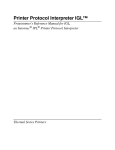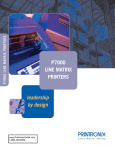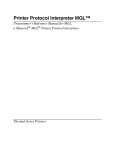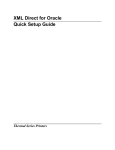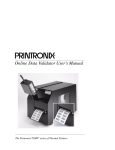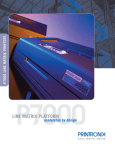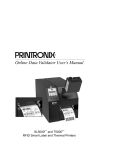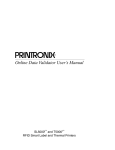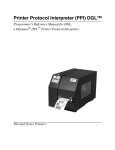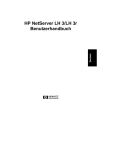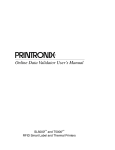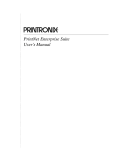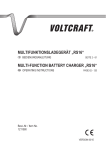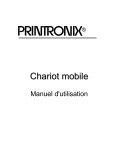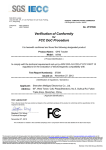Download User`s Manual PrintCart
Transcript
PrintCart User’s Manual PrintCart User’s Manual 251755-001F Trademarks Printronix is a registered trademark of Printronix, Inc. All other trademarks are the property of their respective owners. Product Warranty Printronix, Inc. makes no representations or warranties of any kind regarding this material, including, but not limited to, implied warranties of merchantability and fitness for a particular purpose. Printronix, Inc. shall not be held responsible for errors contained herein or any omissions from this material or for any damages, whether direct, indirect, incidental or consequential, in connection with the furnishing, distribution, performance or use of this material. The information in this manual is subject to change without notice. Communication Notices This device complies with Part 15 of the FCC Rules. Operation is subject to the following two conditions: (1) this device may not cause harmful interference, and (2) This device must accept any interference received, including interference that may cause undesired operation. This Class A digital apparatus complies with Canadian ICES-003. Cet appareil numérique de la Class A est conform à la norme NMB-003 du Canada. Emergency Disconnect Procedure In an electrical emergency disconnect the AC input line cord from any external power source and disconnect the AC output line cords from any equipment powered by the cart. Unterbrechung der Stromversorgung im Notfall Bei einem Notfall im Bereich der Elektro-Installation die Spannungsversorgungskabel von allen externen Spannungsquellen sowie die Spannungsversorgungskabel von allen über das Cart mit Spannung versorgten Geräten abziehen. Notice of Copyright This document contains proprietary information protected by copyright. No part of this document may be reproduced, copied, translated or incorporated in any other material in any form or by any means, whether manual, graphic, electronic, mechanical or otherwise, without the prior written consent of Printronix, Inc. Copyright © 2007, 2010 Printronix, Inc. All rights reserved. Specifications subject to change without notice. Table of Contents 1 Quick Start And Setup .......................................... 7 Quick Start ............................................................................................. 7 Unpacking ....................................................................................... 7 Safety Inspection............................................................................. 9 Equipment Setup ................................................................................... 9 Mechanical Installation .................................................................... 9 Electrical Installation ..................................................................... 10 Startup ................................................................................................. 11 Operating Limitations........................................................................... 12 2 PrintCart.............................................................. 15 Overview.............................................................................................. 15 PrintCart Layout................................................................................... 16 3 Operation ............................................................ 21 Line Power Operation .......................................................................... 21 Battery Power Operation ..................................................................... 23 PrintCart Operating Duration......................................................... 23 Indicator Panel..................................................................................... 24 Gaining Access To The Printer............................................................ 26 Slide The Tray To Service Position ............................................... 26 Load Media Or Ribbon .................................................................. 26 PrintCart Features ............................................................................... 27 PrintCart Accessories .......................................................................... 27 4 Troubleshooting .................................................. 31 Safety................................................................................................... 31 PrintCart Safety Features .................................................................... 32 Troubleshooting Guide ........................................................................ 33 5 Maintenance........................................................ 37 Power Equipment Access.................................................................... 37 Serviceability Inspection ...................................................................... 40 Battery Replacement ........................................................................... 40 Inverter Replacement .......................................................................... 42 Fuse Replacement............................................................................... 43 Display Fuse ................................................................................. 43 Main Fuse ..................................................................................... 43 Power Cord Replacement.................................................................... 44 Wheel Replacement ............................................................................ 45 Caster Wheels............................................................................... 45 Fixed Wheels ................................................................................ 45 Hand Grip Replacement ...................................................................... 46 A Specifications ...................................................... 47 Physical Specifications ........................................................................ 47 Electrical Specifications ....................................................................... 48 B Wiring Schematics .............................................. 49 120V/60Hz ........................................................................................... 49 230V/50Hz ........................................................................................... 50 C Spare Parts ......................................................... 51 D Glossary .............................................................. 53 E Contact Information............................................. 55 Printronix Customer Support Center.................................................... 55 Printronix Supplies Department ........................................................... 55 Corporate Offices................................................................................. 56 1 Quick Start And Setup Quick Start Unpacking WARNING Dismounting the cart from the pallet requires strength. Two people is recommended for the task. 1. Place the pallet on a flat, level surface, leaving enough room to roll the PrintCart off the pallet. 2. Remove the two cardboard protective shipping sleeves and set them aside. 3. Remove the plastic wrap and shipping bag from the PrintCart. IMPORTANT Make sure the caster brake is set. 4. Cut the bands holding the unloading ramps. 5. Lift and remove the ramps off the locating pins. 6. Reverse the ramps and engage the locating pin in the angled blocks on the end of the pallet. See Figure 1. Locating Pin Ramp Figure 1. Reversing the Ramps and Engaging the Locating Pin 7 Chapter 1 Quick Start 7. If necessary set the caster brake on the PrintCart. 8. Cut the shipping restraint tie wraps on all turnbuckles. 9. Insert a screwdriver through the center of each turnbuckle housing and loosen the turnbuckle until you can remove the hook from the eyelet. 10. Unhook the opposite end from the PrintCart frame. See Figure 2. Shipping Restraint Hook Turnbuckle Housing Figure 2. Loosening the Turnbuckle from its Housing 11. On the opposite side of the PrintCart, repeat steps 9 and 10 to completely disengage the shipping restraints. 12. Release the caster brake. Grasp the hand grips and pull the PrintCart down the unload ramps to the work surface. Hand Grip PrintCart Ramp Figure 3. Moving the PrintCart to the Work Surface 13. Replace the unloading ramps on the pallet and store the pallet and turnbuckles for future re-use. 8 Safety Inspection Safety Inspection 1. Inspect the PrintCart for damage that may have occurred during shipment. 2. Open the power compartment door and verify that the batteries are securely restrained and the battery cable connections are tight. 3. Verify that the charger/inverter is held securely in place. If any components have loosened during shipment, secure them before applying power to the PrintCart. Equipment Setup Mechanical Installation NOTE: If applicable, first install the terminal to the PrintCart. Access to the underside of the work surface will be restricted after printer installation. Terminal Installation 1. Follow the manufacturer’s installation instructions to install the wireless terminal. The PrintCart is equipped with a central mounting rail under the stainless steel work surface. This mount is predrilled with 2 rows of 5/16” holes on 1 inch centers. The size and spacing coincides with the hole pattern that mates with the Symbol VRC 8900 series terminals bracket; it may fit several others. The right-most row of holes is centered on the PrintCart frame. The left-most row of holes is centered between the left edge and the barcode scanner storage slot on the right rear of the PrintCart. 2. If the utility drawer is installed, remove the drawer by fully extending the drawer and disconnecting the slide latch. This will provide access to the mounting rail and provide additional overhead clearance. 3. Determine the appropriate mounting location and suitability of the desired mounting bracket. 4. Find the holes (minimum of 2) that will properly position the terminal and mark them on the underside. 5. Use the predrilled mounting rail as a template and drill up through the top work surface using a power hand drill from below. 6. Secure the bracket to the PrintCart according to the manufacturer’s instructions. 9 Chapter 1 Equipment Setup Printer Installation 1. Set the wheel lock on the caster wheel to prevent the PrintCart from moving. 2. Lift the spring loaded handle located on the side of the slide out tray and pull the tray out over the side of the PrintCart to the fully extended position. NOTE: The slide out tray clicks into place when the tray is fully extended. IMPORTANT For Printronix thermal printers, the four rubber pads on the bottom of the printer must be removed. 3. Tip the printer onto the left side (side with power compartment cover) and unscrew the rubber pads. If necessary, use pliers to improve grip. 4. Install the four black rubber vibration mounts that are provided with the PrintCart. 5. Tip the printer back upright. WARNING The next step requires two people; one person to support the printer, the other to align the mounts. 6. Carefully lift the printer and set it on the slide out tray, aligning the threaded vibration mounts with the holes in the tray. The printer’s control panel should face the end of the PrintCart with the hand grips. 7. Secure the printer to the tray using the four supplied lock nuts. 8. Lift the spring loaded handle and slide the tray back under the top work surface of the PrintCart. It should click into a retracted and locked position. Electrical Installation The electrical cable for the PrintCart equipment is routed through the right rear leg into the power compartment. Printer Hook-Up The printer power cable is preinstalled in the PrintCart. 1. Connect the power cable to the printer. Make sure the cord is slightly slack to provide a small service loop during movement of the slide out tray. 2. Test the service loop length by extending the printer shelf and verify that enough slack is available. 3. Bundle and secure any excess cord in the power compartment. 10 Electrical Installation Terminal Hook-Up 1. Install the power supply for the terminal in the pocket provided behind the two slot notebook bin. See Figure 4. Pocket Two Slot Notebook Bin Figure 4. Installing Power to the Terminal If this accessory is not included with the PrintCart: 2. Locate power supply in the power compartment to the left of the inverter. 3. Connect an AC power cord to the power supply and connect it to the remaining receptacle by routing it down through the right rear leg into the inverter compartment. 4. Bundle and secure any excess cord. 5. Route the DC power cable from the terminal to the power supply and secure all excess cable length (terminal P/S pocket behind the letter bin). Startup Make sure all PrintCart equipment has been installed and power cords have been routed and connected to the inverter. 1. Check that the equipment power switches are in the OFF (0) position. The PrintCart is now prepared for start-up. 2. Open the power compartment front door (hand grip end) and connect the main inverter power/battery cable to the connector on the battery subpallet. 3. Open the power compartment rear door and locate the inverter operating switch on the upper-right of the inverter. 4. Slide the switch left to the “AUTO/INVERT” position. The inverter will begin producing power as indicated by the yellow mode indicator on the inverter. 11 Chapter 1 Operating Limitations 5. Close and latch the rear door. Inverter and battery status are indicated on the LED display panel located on the front of the PrintCart adjacent to the hand grips. The batteries in a new PrintCart arrives nearly fully charged. Battery state of charge “gas gauge” shows all LED’s lit, (2 red, 2 yellow, and 2 green). If all of the battery status LED’s are not lilt, charge the PrintCart prior to use. Power is available when the inverter is in the auto position; the equipment may now be switched on. If the connected equipment does not receive power, perform the following: • 120V units Examine the GFCI duplex outlet to the left of the inverter. If the trip indicator lamp located on the right side of the GFCI is illuminated, the GFCI has faulted. Reset the GFCI by depressing the RESET button between the two plugs. • 230V units Examine the “Load C/B” (load circuit breaker) located above the inverter output receptacles. If it extends beyond the mounting more that a couple of millimeters, it has faulted. Reset the load circuit breaker by pressing it in. Close and latch the power compartment door. Operating Limitations When the cart is not in service, leave it plugged in to maintain battery charge. Otherwise, charge the cart battery every 90 days. CAUTION Recharge the batteries as soon as possible after use. Failure to quickly recharge batteries can result in permanent battery damage. Batteries left in a discharged state for extended periods may be so damaged that they will not accept a charge and recharging them could be dangerous. Any attempt to recharge partially discharged batteries left for an extended time requires frequent supervision to ensure that venting or excessive heating does not occur. Do not charge a fully discharged battery at a rate greater than 1/10 of the amp-hour capacity. This cart is equipped with fail safe controls to prevent full discharge. If the batteries become fully discharged, possibly due to long term inactivity, switch the inverter/charger to slow charging mode to revive them. Slow charging prevents further damage to the battery and reduces the risk of battery out-gassing or destructive heating if the battery is damaged beyond recovery. 12 Electrical Installation 120V/60Hz Models Eight switches are located on the top center of the RV750ULHW inverter/ charger front panel. The far left switch is for charge rate. The down (normal) position is fast (45A) charge; the up position is slow (11A) charge. Use the UP position to recharge fully discharged batteries. If the batteries accept a full charge without excessive heating or out-gassing, the capacity selector can be retuned to the full (down) setting. 230V/50Hz Models A red button labeled “Sleeping Mode” is located on the right side of the charger (blue device at the bottom of the power module). Depressing this button reduces the charge rate to approximately 1/3 the normal rate. If the batteries accept a full charge without excessive heating or out-gassing, the sleep mode button can be retuned to the full or out position. WARNING If the batteries become excessively hot or emit a detectable odor, the batteries are damaged beyond repair and are dangerous to use. Stop charging immediately. Remove the batteries from service and dispose of them according to local regulations. Do not charge the batteries at a rate greater than 1/4 of the amp-hour capacity. For example, a 100 amp-hour battery should be charged no faster than 25 amps (or a pair of 100 amp-hour batteries no faster than 50A). The charger on this cart provides the maximum recommended charge rate for the batteries with which it is equipped. CAUTION Do not use additional or larger chargers to speed recharging. Permanent battery damage will occur and the potential for catastrophic failure is high. Before connecting or disconnecting the batteries, turn off battery powered electrical equipment and disconnect both the main DC disconnect and display power cable. Make sure that battery terminal covers are in place to prevent accidental shorts between the battery and surrounding frame or equipment. Use insulated tools to service any power connections that cannot be disconnected from battery power. 13 Chapter 14 1 Operating Limitations 2 PrintCart Overview The PrintCart is a wireless, cordless work platform capable of transporting several pieces of electrically powered equipment to a work site. On site, the PrintCart can operate indefinitely on line power or for an extended period of time (depending on equipment) on battery power. The PrintCart is designed to support continuous operation of all connected equipment without shutting down. The PrintCart contains three separate levels: Bottom Level The bottom level is the power compartment, which houses the power storage, power conversion equipment, and the electrical safety devices that ensure safe PrintCart operation. Middle Level The middle level contains the printer and storage of materials and waste. The printer shelf is mounted on slides that permit a thermal printer to extend out the right side of the PrintCart for service. To the left of the printer shelf is a refuse bin, document holders, and a media storage bin. Above the printer is a utility drawer. Top Level The top level has a stainless steel work area which supports electronic wireless terminal mounting and installation of a barcode scanner storage slot. The power compartment is enclosed and latched with a mechanism that requires a tool to open to prevent incidental access. It contains two sealed lead acid batteries for electricity storage. Power is provided by a combination device called an inverter/charger. Inversion is the process of using the 12 volt direct current stored in the batteries and converting it to a suitable alternating current at a voltage and frequency for operating equipment mounted on the PrintCart. The PrintCart operating voltage can be 120 volts AC @ 60 Hertz (North American standard) or 230 volts AC at 50 Hertz (European standard). Operating voltage is specified at the time of order and can be changed by swapping out the Power Equipment Subpallet (PESP). 15 Chapter 2 PrintCart Layout The battery charge function is performed in the inverter/charger. When AC line power is applied, the inverter charger automatically transfers (switches) power directly to the PrintCart equipment and begins charging the batteries. The charger provides power to the batteries in three separate stages to optimize the storage capacity and battery life. The PrintCart can support multiple pieces of electrical equipment. The primary intent is to support one Printronix four inch or six inch thermal printer on the printer shelf. The PrintCart includes an installation kit consisting of four bolt-on shock mount isolators for securing the printer to the shelf. The top work area can be used for any application but is intended for use with a wireless terminal and barcode scanner. The barcode scanner storage bin can be mounted on the right rear of the work surface. On the front left is a display panel with integral controller. The display panel has a set of battery charge status LEDs that report the battery state of charge. It also has a set of stop light LEDs that display the inverter/charger mode status. Additionally, there is an alarm to alert the user to recharge the batteries. The built-in controller monitors power consumption and signals the user when the batteries need recharging. The controller provides progressive alarms to the user, indicating that there is a warning period to permit completion of the current task, progressing to a shorter shutdown period. This indicates that the PrintCart will soon enter automatic shutdown if not connected to line power for recharging. PrintCart Layout Status Display Barcode Scanner Storage Slot Hand Grip (2) Stainless Steel Work Surface Printer (not included) Battery Access Door Brake/Locking Caster Figure 5. Front Right View of the PrintCart 16 Document Holder (2) Refuse Bin Rear Loop-Handle and Terminal Protector Printer (not included) Power Equipment Compartment Media/Ribbon Storage Power Compartment Latch Power Cord 8” Fixed Wheel (2) Figure 6. Rear Left View of the PrintCart Power Status Indicator Battery Status Indicator Figure 7. Display Panel 17 Chapter 2 PrintCart Layout Inverter Setup Switches AC Output GFCI Grounding Lug (AC) Inverter Display Main Inverter Indicator Power/Mode Switch External Display Panel Connector Positive Battery Cable Input Negative Battery Cable Input Main AC Input Power Circuit Breaker (15A) Battery Charger Circuit Breaker (8A) Figure 8. Power Pallet Features and Safety Devices (120V) 18 Cart Equipment Outlet AC Power Inverter AC Input Circuit Breaker (8A) AC Output Circuit Breaker (5A) Battery Charger Module Battery Charger Sleep Mode Button Location Figure 9. Power Module Features and Safety Devices (230V) 19 Chapter 20 2 PrintCart Layout 3 Operation Line Power Operation When the line cord is connected to a wall receptacle, AC line power is transferred by an Automatic Transfer Switch (ATS) directly to the cart equipment. There is a short delay in applying line power (approximately 20 seconds for the 120V and 8 seconds for the 230V) to permit the plug to be secured in the receptacle. The transfer happens quickly so operation of the connected equipment is not interrupted. NOTE: There is no need to power the PrintCart equipment off when either connecting or disconnecting from line power. When operating on AC line power, the green mode indicator (line power) on the display illuminates. The charger begins to charge the batteries after the ATS transfers line power to the PrintCart. The charger is a three stage device designed for optimal battery charging. • Stage 1 – when the charging cycle starts, the charger provides maximum rated charge until the battery reaches approximately 75% capacity. Completely charging the battery before reusing the PrintCart provides good PrintCart longevity. • Stage 2 – the charge rate is reduced from full capacity to 10% capacity to charge the last 25% of the battery. Completion of second stage charging only slightly improves short term operating longevity but greatly improves long term battery life. • Stage 3 – when the battery is fully charged, a trickle charge is applied to keep the battery at full capacity. The time required for a recharge depends on the state of discharge, the size of the battery bank, and the charger’s capacity. The PrintCart controller prevents the batteries from discharging more than 70% of their energy (Depth of Discharge or DoD); this reduces the rate of permanent battery damage. Maximum recharge times for the PrintCart are listed in Table 1 on page 22. When the charging begins, the charger will indicate battery state improvement through the State of Charge (SoC) LEDs, but displays differently between the 120V and 230V carts. 21 Chapter 3 Line Power Operation • 120V – as charging progresses, yelow and green bars illuminate individually with each 10-15% increase in charge state. • 230V – the two red bars light when the charger is in Stage 1 (30-75% charge). When the charger enters Stage 2 (76-98% charge), the two yellow lights also illuminate. The two green lights illuminate together when the charger enters Stage 3 (greater than 98% charge). When all SoC lamps are illuminated, the PrintCart is fully charged. When battery power is available to the PrintCart, the Battery Powered mode indicator (yellow) illuminates. When the PrintCart is connected via line power, the Line Powered mode indicator (green) illuminates. Make sure the source of AC power is through a modern 3-prong grounded outlet and is a reliable service capable of delivering the required current. Normal and maximum current specifications are listed in Appendix A on page 47. Table 1 on page 22 shows the maximum recharge time. Table 1. PrintCart Charge Time Battery Type 2x100 Ah Maximum (hrs) Typical (hrs) 4.7 3.7 The line cord design uses a short PrintCart cord connected to an extension cord. The two are connected together inside a cord wrapping device. This method provides an easy, user level repair to encourage maintenance. The cord can be replaced with a variety of cords as long as they meet the original specification and are not longer than 25 feet. See “Spare Parts” on page 51 for cord requirements. IMPORTANT 22 Using a cord or series of cords longer than 25 feet may result in power loss. This could affect operation of either the PrintCart equipment or power system. PrintCart Operating Duration Battery Power Operation When the PrintCart is unplugged from the AC outlet, the power system automatically switches equipment to inverter power via the automatic transfer switch. NOTE: The PrintCart equipment does not have to be turned off and there will be no significant power interruption to the equipment. The Battery Powered mode indicator (yellow) on the display indicates that the battery is now providing power. When running in Battery Powered mode, the battery system is no longer being charged. PrintCart Operating Duration 1. Select a printer family (SL4M/T4M or SL5000r/T5000r). Other printer models are categorized between the two printer families. 2. Within the printer family, select whether a notebook or wireless terminal will be used. NOTE: A desktop or compact PC is not the same as a notebook or terminal due to higher power consumption. 3. Determine the minimum operating time (in hours) at the intersection of the battery bank row and the equipment column. Table 2. Minimum Hours of System Operation Before Automatic Shutdown Battery Bank Capacity (Ah) 2x100 SL4M/T4M with Wireless Terminal SL5000r/T5000r with Wireless Terminal Printer Weight Average Printer with Notebook Weight Avearge Printer Weight Average Printer with Notebook Weight Average 35.4 18.6 19.9 13.2 NOTE: The operating time span specified is the minimum available at the end of battery life. This ensures that operational requirements will be met as the battery capacity declines by approximately 30% as the battery ages. NOTE: Frequently charging the PrintCart prior to reaching maximum allowable discharge will maintain battery life and delay declining capacity. 23 Chapter 3 Indicator Panel Indicator Panel Colored LEDs on the indicator panel displays operational status. The display is arranged in two sections: battery indicator (state of charge) on the left and power status (operating mode) on the right. Battery Indicator (gas gauge) Power Status Mode Indicators Figure 10. Display Panel Layout Indicator Colors NOTE: All power status mode indicators will not display simultaneously. Battery Indicator (at full battery charge) Battery Powered Mode Figure 11. Operating in Battery Powered Mode with a Full Battery Charge NOTE: The yellow LED illuminates in Battery Powered mode with a full battery charge. Battery Indicator (charging at stage 1, gas gauge red) Line Powered Mode Figure 12. Operating in Unrestricted, Line Powered Mode NOTE: In unrestricted, Line Power mode, the green LED is illuminated. Battery power is available if line power is disconnected. 24 PrintCart Operating Duration Fault Mode Battery Indicator (discharged battery, flashing red gas gauge) Line Powered Mode Figure 13. Discharged Battery, Operating on Inverter NOTE: When the battery is discharged, the alarm timer activates (flashing red gas gauge) and the battery operates on inverter. An illuminated Fault mode LED indicates that either the charger or the inverter are not operating correctly. A fault will not prevent the cart from operating in Line Power mode but the cart will not operate correctly on battery power. Stop operation and report the problem to supervisors and maintenance personnel for corrective action. Implement the following restrictions to protect the batteries: • Battery discharge is limited to 70% (as low as 30% state of charge). When the SoC reaches the discharge trigger at 40% (2 red) a warning timer starts and the state of charge indicator flashes slowly. The warning timer default is 60 minutes during which the cart will operate. When the warning timer expires, the shutdown timer starts. The state of charge indicator begins flashing more rapidly and an audible beep sounds. The shutdown timer default is 10 minutes during which the cart should no longer be used and should be plugged in as soon as possible. Failure to begin charging prior to expiration of the shutdown timer will result in a cutoff of all power to the cart equipment. • A minimum amount of battery recharge must occur prior to permitting the cart to return to cordless operation. If the battery discharge trigger is activated, that is an indicator that the discharge was significant. The recharge that follows must restore approximately half the charge before the cart can be used in cordless mode again. Power shutdown control is achieved through the warning and shutdown timers. Once activated, the timers can only be stopped by plugging in the cart. A stopped timer will restart any time the cart is unplugged provided that the charge level has not been raised enough to be reset. The reset level for the 120V cart is 60% (2 red and 1 yellow). The reset level for the 230V cart is 75% (2 red and 2 yellow). The SoC indicator continues to flash during charging to indicate that the discharge floor was reached and the timers have yet to be reset. 25 Chapter 3 Gaining Access To The Printer If the cart is unplugged prior to the reset, the timer controlled shutdown will resume from its previous activation and shut down the cart when the remaining time expires. If both timers have previously expired, the cart will shut down immediately. • If the FAULT (red) mode LED illuminates, that indicates there is apower irregularity. 120V: if lit, the inverter is providing power in excess of its continuous duty rating and will overheat if maintained long enough (a safe operating condition). If flashing, the inverter has shut down due to overheating. 230V: if lit, either the charger or the inverter is not outputting power when it should. It is also possible for the fault light to illuminate for a sort time if the charger is working but the batteries are very significantly discharged. • A fault does not prevent the cart equipment from operating in Line Power Mode. However, the cart will not operate on battery power and should be removed from operation and reported to supervisors and maintenance personnel for corrective action. Gaining Access To The Printer The printer is mounted on a slide out shelf to provide quick access for servicing or media and ribbon replacement. Slide The Tray To Service Position 1. Locate the shelf lock handle located under the tray on the side of the PrintCart. 2. Make sure there is enough slack in the printer power cord to permit 10 inches of sideways movement. 3. Pull up on the spring-loaded lock handle and slide the tray with the printer out of the right side of the PrintCart until the tray locks in the full outboard position. You will hear a click when the tray reaches the full outboard position and the printer will not be able to slide back in. Load Media Or Ribbon 1. Open the printer side media cover and follow the loading instructions in the printer’s user’s manual. WARNING The media cover will only open to approximately 90 degrees. Be careful not to hit your head on it while working. 2. When printer servicing is completed, close the media cover, depress and hold the lock handle and slide the printer back to its retracted position. 3. Make sure the power cord does not become tangled. 4. Place the printer back online. 26 Load Media Or Ribbon PrintCart Features Wheel Brake/Lock The PrintCart is equipped with a wheel brake/lock on one of the front casters. When applied, the brake prevents the wheel from rotating and the lock prevents the caster from pivoting. Set this brake when using the PrintCart on a non-level surface or loading ramp. This feature is standard on all PrintCarts. Wheel Brake/Lock Figure 14. PrintCart Wheel Break/Lock PrintCart Accessories Refuse Bin A waste container is provided on the left side of the PrintCart near the front. To dump the container, tilt it out and down far enough to permit dumping of contents. CAUTION Do not pour liquid into this container as it is not liquid tight. The liquid could enter the power compartment and cause damage. Refuse Bin Figure 15. Dumping the Refuse Bin 27 Chapter 3 PrintCart Accessories Document Holders A factory or field installable dual document/notebook holder allows local storage of documents. The holders are recessed to prevent damage when the PrintCart is moved close to other objects. Document Holders Media Storage Compartment Figure 16. Dual Document Holders and Media Storage Compartment Media Storage Compartment A media storage compartment is either factory or field installable. It allows the storage of one printer ribbon up to 6 3/4” wide and 4” in diameter, and one roll of media up to 6 3/4” wide and 8” in diameter. See Figure 16 on page 28. Barcode Scanner Storage Slot A barcode scanner storage slot is either factory or field installable. It prevents the scanner from accidentally falling off the PrintCart. Barcode Scanner Storage Slot Utility Drawer Figure 17. Barcode Scanner Storage Slot and Utility Drawer 28 Load Media Or Ribbon Utility Drawer A utility drawer is available to store up to 8 1/2 x 11” size paper as well as other small items. This allows the top work surface to be kept clutter free. Power Cord The power cord is wrapped on a hanger on the left side of the power compartment (see Figure 18 on page 29). The line cord exits the power compartment through a hole with a grommet around it, in the center of the cord hanger. It is intentionally not long enough to reach either a wall receptacle or the floor. PrintCarts can be rendered inoperative due to power cord damage resulting from driving over the plug or pulling the cord to disconnect it from a wall receptacle. To operate the PrintCart, an external cord must be attached (one is supplied and installed). The 120V PrintCart is supplied with a heavy gauge (14 awg) cord approximately 10 feet long. The 230V PrintCart is supplied with a 4.3 m (3 wire, 2mm) standard business machine power cable. An extension from the inverter input provides an IEC 320 receptacle for connection of the business machine cable. Choosing the appropriate business machine plug type at time of order accommodates differing plug types. The appropriate cord is attached to the PrintCart and secured with a connector lock. The locked connectors are stored inside the cord hanger and the extension cord exits the front of the hanger through a hole with a grommet around it. When the AC extension cord is not being used, wind it around the hanger. This prevents the cord from becoming a trip hazard or damaged by getting stepped on or driven over. The cord hanger has extended flanges to ensure the cord will not unwind during transport. The cord hanger is not intended to carry more than 25 feet of cable. Hanger Hanger 120V NEMA 5-15 Plug and 10 ft. Extension Cable 230V - 4.2M UK Business Machine Cable Figure 18. Power Cords 29 Chapter 30 3 PrintCart Accessories 4 Troubleshooting Safety During any troubleshooting activities that require access to the power compartment, you must disconnect the input AC power cord from any external AC outlet and set the inverter main switch to the OFF (center) position. This removes the presence of any high voltage AC power. Always work on a level, dry area with the caster brake set to prevent accidental PrintCart movement. IMPORTANT WARNING WARNUNG Allow only trained personnel access to the power compartment. Gestatten Sie nur geschulten und befugten Mitarbeitern den Zugang zum Stromversorgungsfach. This product contains lead-acid batteries. Special care must be taken when handling batteries. • • • Batteries contain toxic materials; handle batteries with care. • Prevent positive and negative terminals from contacting each other (short circuit). Shorting terminals causes permanent battery damage and can result in a fire or serious personal injury. • Do not remove or lift the battery by its output leads. Move or lift the battery by picking up its case or by using the integrated handles. • Dispose of batteries in according to local regulations. Lead acid batteries may not be disposed of in household or industrial waste containers. Disposal through hazardous waste facilities/services is required to avoid ecological harm from battery materials. Severe penalties may result from improper or illegal disposal. Do not puncture, disassemble or incinerate batteries. Charge batteries in a well ventilated area away from ignition sources. Dieses Produkt enthält Bleiakkus. Beim Umgang mit Batterien ist besondere Sorgfalt geboten. • Akkus enthalten Giftstoffe und sind daher besonders sorgfältig zu handhaben. • • Akkus keinesfalls zerstören, zerlegen oder verbrennen. Akkus in einem gut belüfteten Raum und nicht in der Nähe von Zündquellen laden. 31 Chapter 4 PrintCart Safety Features • Der Kontakt zwischen positiven und negativen Anschlüsse ist unbedingt zu vermeiden (Kurzschluss). Kurzschlüsse können Akkus dauerhaft schädigen und einen Brand oder Verletzungen verursachen. • Den Akku keinesfalls an den Ausgangsleitungen fassen, um ihn zu entfernen oder anzuheben. Fassen Sie den Akku stets am Gehäuse oder an den integrierten Griffen. • Akkus den lokalen Vorschriften entsprechend entsorgen. Bleiakkus keinesfalls im Hausmüll oder in Behältern für Industrieabfälle, sondern zur Vermeidung von Umweltbelastungen als Sondermüll entsorgen. Für unsachgemäße und illegale Entsorgung können empfindliche Strafen verhängt werden. California Proposition 65 WARNING Battery posts, terminals, and related accessories contain lead and lead compounds, chemicals known to the State of California to cause cancer and reproductive harm. Wash your hands after handling batteries. PrintCart Safety Features The PrintCart is equipped with numerous electrical safety devices to interrupt electrical power should electrical malfunctions or overloads occur. These devices are designed to protect both the power equipment and the operator. They are located in the power compartment and can be accessed through the front and rear access doors using a screw driver or coin. NOTE: Access to the power compartment should be limited to specifically trained and authorized personnel. The 12VDC battery input to the inverter is protected with a 100-amp flat lug type input fuse. It is bolted to the battery subpallet on top of the batteries and is covered by a snap-on plastic cover which must remain in place when the service disconnect is connected. The fuse has no visible indicator of its condition, and operability must be confirmed with an electronic meter. The 12VDC power to the upper display/control is provided through a two wire, 16 gauge cable bolted directly to the front battery. This cable includes an automotive type ATC blade fuse adjacent to the positive battery terminal to protect the circuit. CAUTION Prior to accessing the display panel, unplug the quick disconnect to prevent any electrical shorts during access. The AC input is protected by two circuit breakers, both mounted on the inverter. There is a breaker for the charger portion of the inverter/charger subsystem located immediately to the right of the inverter fan shroud (same for 120V and 230V models). It is 8 Amperes for 120V charger and 3/5 Amperes for the 230V charger. The second breaker differs in capacity, location, and purpose between the 120V and 230V units, as follows: 32 • For the 120V PrintCart input, there is a 15 ampere main circuit breaker mounted on the inverter connector panel. It controls all input power to the PrintCart and when tripped, interrupts both charger power and passthrough (ATS) power. • For the 230V PrintCart input, there is no main breaker. There are separate breakers for the charger and transfer power. The transfer breaker is 4/6 Amperes and is located to the right of the charger breaker. In this case, if either breaker trips, the other branch remains powered. Troubleshooting Guide Table 3. Troubleshooting Problems Symptom Primary No AC ouput regardless of presence or absence of AC input. Possible Cause Corrective Action Secondary All indicator lights are off. Main DC cable is disconnected from battery. Connect main DC cable to battery. DC power cable is unpluged from relay PCBA. Connect DC input to relay PCBA. Relay PCBA blad fuses open. Check and replace the right most 1A blade fuses on relay PCBA. Batteries are completely discharged or unserviceable. Charge batteries with an external battery charger for 20 minutes. Switch onboard charger to sleep mode by depressing the red square button on the right side of the charger This lowers charging rate to reduce the hazard of charging unserviceable batteries. Reconnect to AC line power. If a full recharge solves the problem, deactivate sleep mode. Defective relay or display PCBA. Replace PCBA. 33 Chapter 4 Troubleshooting Guide Table 3. Troubleshooting Problems Symptom No AC output in battery mode. AC input is not present. 1. Battery mode LED (yellow) is off. No AC output in battery mode. AC input is not present. (continued) 1. Battery mode LED (yellow) is off. 34 Possible Cause Corrective Action Battery is below shutdown threshold and has shut off inverter power to prevent battery damage. Plug in and recharge until battery meter no longer flashes or until a full charge is achieved (preferred). Inverter output is unplugged. 2. Battery charge is greater than 2 red. Plug output cord into inverter (right side of top equipment on power module). Inverter is switched off. Switch inverter on (right side of top equipment on power module). 3. Fault mode LED (red) is flashing. Inverter fuse is open or inverter has failed. Evaluate potential cause of overload and remove. Replace inverter (fuse not replaceable). 1. Battery mode LED (yellow) is on. Equipment power cords are not connected to power module outlet. Connect power cords to the power module outlets. 2. Battery charge is ok. Output circuit breaker is tripped (bottom push button breaker). Disconnect load and reset output circuit breaker by pressing it back in. Reconnect and switch loads on one at a time. 2. Battery charge is red and flashing. Table 3. Troubleshooting Problems Symptom AC input is connected but not shown as available. AC input is connected and available but the charger is not charging. 1. Line mode LED (green) is off. Possible Cause Input circuit breaker is tripped (top push button breaker). Disconnect load and reset input circuit breaker by pressing it back in. If charger operates, reconnect and switch loads on one at a time. Power is not present in wall socket. Test presence of power in wall socket with another piece of equipment or meter. Input extension cord has broken internally. Replace input extension cord. Input extension has separated from cart input cord inside the cord wrap. Inspect cord coupling and ensure securing clip is in place and functional. Relay or display PCBA is defective. Replace PCBA. Charger is switched off. Turn on the charger switch on the left side of the charger (lower piece of equipment). Charger fuse is open. Replace charger fuse on left of charger (round black projection). Charger is inoperative. Replace charger. 2. Charger is not operating. 1. Line mode LED (green) is on. 2. Fault mode LED (red) is flashing. 3. Charger fan is not operating. Corrective Action 35 Chapter 36 4 Troubleshooting Guide 5 Maintenance Power Equipment Access Gain access to the power equipment through tool latchable doors on the front and rear of the PrintCart. Inside the power compartment, the power system is divided into two separate replaceable subpallets. The battery subpallet (BSP) contains the two batteries, the main fuse battery and the quick disconnect battery. The power equipment subpallet (PESP) contains the inverter/charger, a GFCI duplex outlet (120V version), and a power quick disconnect cable to the BSP. These subpallets can be removed independently and are held in place by a set of restraining bolts located on the outside of the PrintCart near the bottom edge. NOTE: It is not necessary to move the equipment subpallet inside the frame to access the power equipment for inspecting or resetting safety devices (breakers or GFCI). Simply open the door and all devices are visible and readily accessible. If greater access is required, such as for servicing equipment or replacing batteries, the subpallets can be completely removed (see “Power Equipment Subpallet (PESP) Removal” below). Make sure that the screws joining the two subpallets are removed. Some factory configurations are shipped with the PESP bolted to the BSP; they must be removed as a single unit and the mating bolts removed before the subpallets can be handled separately. To remove the pallet as a single unit, disconnect the PESP side as indicated below but do not remove it. Prepare the BSP and remove the entire unit as indicated in the BSP removal process (see “Battery Subpallet (BSP) Removal” on page 39). NOTE: It is not necessary for the subpallets to be joined for proper operation and they may be replaced in the PrintCart as separate units. Power Equipment Subpallet (PESP) Removal 1. Make sure the mating screws joining the two subpallets are removed. 2. If PrintCart is plugged into an AC outlet, disconnect the plug from the outlet. 3. Open the rear access door on the inverter side. 4. Shut off the inverter/charger main switch located on the front of the inverter. 5. Disconnect the PrintCart equipment power cords either in the CFCI (120V) or in the face of the inverter (230V). 6. Disconnect the blue inverter display data cable from the inverter. 37 Chapter 5 Power Equipment Access 7. Loosen the AC grounding lug and remove the green grounding wire that runs to the PrintCart frame. 8. Open the front door of the PrintCart and unplug the battery main quick disconnect. 9. Disconnect the AC input cord according to the model you have. 120V PrintCart a. Unwind the extension cord and expose the plug connector stored inside the cord wrap. b. Raise and disconnect the coupled plugs. c. Push the plug through the grommet hole, back into the power compartment. d. Pull the short input cord and wrap it over the inverter to make sure it does not catch. 230V PrintCart a. Unplug the IEC 320 input plug from the front of the inverter and hang the cable out of the way over the door. 10. Remove the two restraining bolts located on each side of the PrintCart that hold the equipment subpallet. 11. Slide the equipment pallet out the rear door far enough to get a good grip on it. Be prepared to support 25 lbs of the subpallet. 12. Pull the subpallet out the remaining distance and lift the unit from the PrintCart. Power Equipment Subpallet Figure 19. Power Equipment Subpallet 38 Battery Subpallet (BSP) Removal 1. If the PrintCart is plugged into an AC outlet, disconnect the plug from the outlet. 2. Open the rear access door. 3. Shut off the inverter/charger main switch located on the front of the inverter. 4. Open the front door and disconnect the main battery quick disconnect and hang it so it is out of the way. 5. Disconnect the display power cord quick disconnect and move it to the side. 6. Remove the two side restraining bolts that hold the BSP in place. These are located on the side of the PrintCart frame. 7. Obtain a pallet jack and center one leg of the jack approximately 18 inches under the BSP. 8. If using a pallet jack, lift the BSP about 1/4 inch and slowly pull back on the jack to remove the pallet from the PrintCart frame. If the BSP gets caught with the PrintCart, the lift may be either too little or too much. WARNING The BSP weighs between 150 and 230 lbs (depending on batteries used). Be careful when removing the battery subpallet. Battery Subpallet Pallet Jack Figure 20. Battery Subpallet 39 Chapter 5 Serviceability Inspection Serviceability Inspection NOTE: Only trained personnel should perform this inspection/maintenance. Periodically open the power compartment and inspect the internal components for signs of loose connections, excessive dirt and dust buildup, or any other condition that is out of the ordinary. Clean the cooling fan intake and exhaust ports on the inverter every six months. Other ventilation features should also be serviced at that time. Any time the power compartment is accessed, disconnect the AC line power cord from AC power and set the inverter to the OFF position. Battery Replacement Battery replacement is only required when batteries fail to hold sufficient charge to support PrintCart operational requirements. If operated in accordance with these instructions, the batteries should perform well for a minimum of 3 years (600 charge/discharge cycles of 70%). Batteries will slowly lose some of their charging capacity over time. This should be noticeable but will not affect operational requirements. When the batteries begin to fail, both batteries will not necessarily fail together but the failure of one battery will cause the failure of the other. By the time you notice a significant degradation in performance, one battery has already failed and has probably damaged the remaining battery enough that it cannot recover. For this reason, both batteries must be replaced at the same time. Both replacement batteries must also be identical in capacity, and preferably be made by the same supplier. Replacement batteries must conform to the standards established in the repair parts section for dimensions, battery type, and terminal type (see “Electrical Specifications” on page 48). Adherence to these requirements will ensure that you do not compromise safety and performance standards. WARNING Because of the high electrical energy and potential for flammable gases associated with lead acid batteries, use extreme care when servicing the batteries. Maintenance must be done in a well-ventilated area by a trained service technician. The service technician must wear safety glasses, leather gloves, and steel-toed boots or shoes. To easily and safely replace the battery, remove the BSP first (see page 39) and place it on a suitable work surface. WARNING 40 Do not work on the BSP while it is resting on the pallet jack fork. To Replace Batteries 1. Lift the protective covers on the battery (-) terminals and remove the bolts and washers holding the cables in place. See Figure 21 on page 42. 2. Perform the same operation on the battery (+) terminals. Be sure to save all nuts, bolts and washers removed. 3. Loosen and remove the battery clamp knob. 4. Lift the clamp plate, cables, fuse and disconnects from the battery pallet as a single unit. 5. Ensure the pallet is fully supported all around, then remove both batteries from the subpallet one at a time and set them aside for disposal. 6. Obtain a new set of batteries to be installed and place them into the same position on the subpallet as the old batteries. Be sure and observe that the polarity of the battery terminals is correct. WARNING Exercise care in lifting. Use a second person if necessary to avoid back strain. If the batteries are a different length, adjust the bottom brackets to the appropriate width to keep both batteries centered. If the batteries are a different height, loosen the lock nut at the base of the thread rod and raise or lower the thread rod to make the top approximately 1/2” to 3/4” higher than the top of the battery. 7. Replace the clamp plate and secure the center knob so it is tightly snug. 8. Re-install the battery terminal wiring (red to (+) positive terminal and black to (–) negative terminal) and secure the terminal hardware. WARNING Reversing battery polarity on the interconnect cables could result in damage to the cables and batteries and can also cause an explosion. Make sure that the terminal covers are also in place and adequately cover the terminal hardware. 9. Re-install the BSP into the PrintCart frame. 10. Install the restraining bolts on both sides of the PrintCart to secure the pallet in place if daily battery exchange is not practiced for PrintCart operation. Before installing the screws, use the tip of the screwdriver to insure the hole in the BSP is aligned with the hole. 11. Re-connect the LED display power cord and the main battery disconnect. 12. Close and latch the front door. This completes the battery replacement procedure. Be sure to fully charge the new batteries before using them. 41 Chapter 5 Inverter Replacement Battery Clamp Knob Battery (-) Protective Covers Battery (+) Protective Covers Clamp Plate, Cables, Fuse, and Disconnects Figure 21. Replacing the Battery Inverter Replacement Make sure other causes for power failure are eliminated before replacing the inverter, (see Table 3, Troubleshooting Problems on page 33). Simple inspection may prevent unnecessary replacements. The inverter is an integral part of the power equipment subpallet (PESP) and is not available as a stand alone unit. The PESP must be replaced as a single unit. The removal process is described in “Power Equipment Subpallet (PESP) Removal” on page 37. Figure 22. Inverter Replacement 42 Display Fuse Fuse Replacement There are two fuses on the PrintCart: • Display Panel Fuse – located between the front most battery terminals in an in-line holder. • Main Fuse – located on top of the battery clamp plate inside a black plastic housing. An open fuse means an abnormal situation exists in the power system. Excessive equipment loading or possible short circuits may exist. Carefully examine all components and wiring in the system for damage before replacing a fuse to prevent a re-occurrence of the failure. Display Fuse 1. Open the rubber fuse holder and pull the blown fuse out. 2. Replace only with an identical 1 Amp blade fuse (ATO 1). 3. Close the rubber fuse holder after replacement. Main Fuse 1. Switch the inverter OFF. 2. Unplug the DC power service disconnect on top of the battery clamp plate. 3. Unplug the LED display power cord disconnect. 4. Using a pallet jack or subpallet carrier, remove the battery pack. 5. Lift the snap-on cover on the front until it opens. 6. Loosen and remove both M8 nuts (13 mm or 1/2 inch open end wrench) and carefully lift the fuse from the threaded terminal posts. 7. Install the new fuse onto the studs. 8. Reverse the above procedure to reinstall connections. M8 Nuts Figure 23. Replacing the Main DC Power Fuse 43 Chapter 5 Power Cord Replacement Power Cord Replacement The AC line cord (power cord) is designed to be user replaceable. The connection between the external cord and the inverter input cord is located in the cord hanger on the side of the PrintCart. 1. Completely unwrap the cord from the storage hanger. 2. Lift the plug connector out of the hanger recess. 3. Remove the cord coupling and disconnect the two cords. 4. Obtain a proper replacement extension cord and reverse this procedure to reinstall. The 120VAC and 230VAC PrintCarts have different connector styles. The 120VAC PrintCart uses a NEMA 5-15 connector (see Figure 24). The 230VAC PrintCart uses an IEC-320 connector (see Figure 25). The IEC 320 connector allows a variety of business machine power cables to be used depending on the connector the user requires. NEMA 5-15 Connector Figure 24. NEMA 5-15 Connector IEC-320 Connector Figure 25. IEC-320 Connector 44 Caster Wheels Wheel Replacement Caster Wheels Removal Recommended replacement caster wheels are specified in the repair parts section (see “Spare Parts” on page 51). 1. Prevent the PrintCart from rolling by placing a 3/4 inch (approximately 19 mm) thick board behind the fixed wheel. 2. Elevate and support the entire end of the PrintCart, lifting the caster end approximately 1 inch off the ground. 3. Remove the three 5/16 Nylock retaining nuts (1/2 inch open end wrench). 4. Remove the caster wheel. Installation 1. Install the new caster by reversing the above process. 2. Make sure the nuts are tight. 3. Replace any nylock nuts if the nylon locking element is too worn to provide retention. Casters are available in various brands and styles. If the replacement is a different brand than the original, it may be necessary to replace both since caster mount heights vary enough to cause the PrintCart to rock. Fixed Wheels Removal Recommended replacement wheels are specified in the repair parts section (see “Spare Parts” on page 51). 1. Engage the caster wheel lock. 2. Lift and support the entire end of the PrintCart so the wheel is raised approximately 1 inch off the ground. 3. Remove the external snap ring and thrust washer from the end of the axle. 4. Remove the wheel. Installation Install the new wheel by reversing the above process. The wheel is a commonly available style using an 8 inch outer diameter and a 5/8 inch bore. The hub is offset. Local replacements may be available that fit this requirement. If the replacement is not identical to the original, it may be necessary to replace both to ensure that the PrintCart does not rock. 45 Chapter 5 Hand Grip Replacement Hand Grip Replacement 1. Remove the hand grips by placing your fingertips on the innermost shoulder of the grip and pulling it straight off the steel handle. If that is too difficult, insert a small flat screwdriver blade under the grip to loosen it and stretch the grip away from the steel handle. 2. Twist the grip while pulling it off. 3. Install the new grip onto the handle by pushing only on the end of the grip. If it is too tight, apply a small amount of a mild solution of soap and water. Replacement grips can be found from local sources and need to fit a 1 inch outer diameter tube. Some are specified in the spare parts section (see “Spare Parts” on page 51). 46 A Specifications Physical Specifications Characteristic North American (120V/60 Hz) European (230V/50Hz) Operating Height (SS top/barcode storage) 40 in./47 in. (101.6 cm/119.4 cm) Width (frame/wheels) 21 in./22 in. (53.3 cm/55.9 cm) Length (SS top/handles) 25 in./36 in. (63.5 cm/91.5 cm) Weight (without printer or terminal) 280 lbs (127 kg) Printer Shelf Load Capacity 70 lbs (32 kg) Work Surface Stainless Steel 21 in. (53.3 cm) wide x 25 in. (63.5 cm) long Printer Slide-Out Shelf Painted Steel 14 in. (35.6 cm) wide x 20.25 in. (51.4 cm) length with predrilled mounting for SL5000r/ T5000r printers. Includes shock mounts. Printer Shelf Extension 11 in. (27.9 cm) Wheels 2 - 5 in. (12.7 cm) caster, one locking (front) 2 - 8 in. (20.3 cm) fixed wheel (rear) 47 Appendix A Electrical Specifications Electrical Specifications Characteristic North American (120V/60 Hz) European (230V/50Hz) Battery Capacity 2 x 100 Amp-hour Recharge time to recover 60+% charge Battery Type Sealed Lead Acid, Absorbed Glass Mat (AGM) Charger/Inverter Type RV750ULHW APSX600 AC Inverter Output 120V/60 Hz/750 w 230V/50 Hz/600 w 12VDC Charger Capacity 45A 45A Input Current (Maximum) 15A (@ 120VAC) 8A (@ 230VAC) Input Plug NEMA 5-15 male 3-prong plug (fixed) User selectable (IEC 320 male socket connector) Output Receptacle 2 - NEMA 5-15 on GFCI 2 - IEC 320 female Warning Alarm - working time prior to shutdown alarm 60 minutes Shutdown Alarm - delay prior to shutdown 10 minutes 48 3.2 hr 4.0 hr B Wiring Schematics 120V/60Hz Figure 26. Wiring Schematic for North American Models (120V/60Hz) 49 This design concept consists of a 2 part control system. A "relay" PCBA manages AC power switching and a display/control PCBA for control logic and display functions. The relay PCBA is located in the cart power module interconnected compartment where equipment and cabling can connect directly. The display/control PCBA is located in the top front left corner of the cart where it is visible to the user. It is linked to the relay PCBA with a 7 ft. Cat 5 network cable. The micro-controller senses DC voltage separately for charge and discharge cycles and displays a relative battery state of charge on the 6 segment LED bar display. Appendix B 50 230V/50Hz 230V/50Hz Figure 27. Wiring Schematic for European Models (230V/50Hz) C Spare Parts Description Capacity Style Printronix PN Battery, AGM 100 Amp Hr NB Terminal 205235-001 Battery Charger (230VAC) 12v @ 45A 230V 50 Hz 205327-001 750 Watt-120V 120V 60 Hz 205394-001 600 Watt 12VDC Input 205334-001 100 A Bolt through tab 205296-001 Display Fuse 2A Std Blade 205297-001 Display Fuse 1A ATC Blade 211014-001 Output Breaker 5A - 230V Push to Reset 211040-001 Input Breaker 8A - 230V Push to Reset 211041-001 5 inch Caster 300 lbs Bolt on Plate 205300-001 5 inch Caster with Lock 300 lbs Bolt on Plate 205299-001 8 inch Offset Wheel 400 lbs 5/8 inch ID with Bearing 205301-001 14 ga./3 wire NEMA 5-15 plug 205426-001 240V, 6A, UK, Detachable 6A UK 3 Prong 102512-007 250V, 6A, Shuko Detachable 6A UK 3 Prong 102512-004 Separable PCBAs Version 3 only 253090-001 Fit 1 inch OD Cushioned, Smooth 205339-001 Inverter (120VAC) Mod. Sine Inverter (230VAC) Main DC Fuse Power Cord Relay & Display PCBA Rubber Hand Grip 51 Appendix C 52 D Glossary AC Alternating Current, current that reverses direction periodically. The output of the inverter system or a wall receptacle is AC power. AGM Absorbed Glass Mat, the type of lead acid battery used in the PrintCart. The electrolyte in the battery is absorbed into a fiberglass sheet in proximity to the lead plates. Amp Ampere, a measure of electrical current. One coulomb of charge per second equals 1 Amp. Amp-Hour A term used to describe the charge storage capacity of a battery. For example, a 100 amp-hour battery should be able to deliver a current of 10 amps for 10 hours or 5 amps for 20 hours, etc. Battery An electro-chemical storage device that stores electrical charge. Charger An electrical device that supplies electrical current, used to replace the charge in batteries. Circuit Breaker An electronic device designed to open or break a circuit when the current flowing through the device exceeds a specified amount, and which can be reset to allow current to flow. Coulomb A unit of electrical charge equal to the quantity of electricity transferred by a current of 1 Amp in 1 second. Current The amount of electrical charge flowing through a wire or circuit per unit time. It is measured in Amperes. DC Direct Current, current that flows in a single direction. Depth of Discharge A term used to describe the percentage amount of the total charge that has been drained from a battery. For example, if the depth of discharge of a battery is 70%, that means that 70% of the total charge has been drained leaving approx. 30% remaining in the battery. 53 Appendix D 54 Electrolyte An ionic solution, usually distilled water and sulphuric acid, that enables the flow of electrons in a battery from the negative plate to the positive plate. Fuse An electrical device designed to melt, break, or open when electrical current flowing through it exceeds the specified amount. Its purpose is to protect electrical circuitry from damage caused by excessive current flow. Inverter An electrical device that converts direct current (DC) into alternating current (AC). LED Light Emitting Diode. Used in the PrintCart display. Load A descriptive term used to represent a piece of equipment or anything that requires or draws electrical power to operate. OEM Original Equipment Manufacturer. Power The mathematical product of Voltage x Current. Expressed in the units of Watts. State of Charge A term used to describe the percentage of total charge that remains in a battery. For example, if the state of charge in a battery is 70%, it means that 70% of the total charge capacity is still present in the battery and roughly 30% has been drained. Volt A unit of electrical potential or electromotive force. The PrintCart electrical system is based on 12-volt batteries. E Contact Information Printronix Customer Support Center IMPORTANT Please have the following information available prior to calling the Printronix Customer Support Center: • • • • Model number Serial number (located on the back of the printer) Installed options (i.e., interface and host type if applicable to the problem) Configuration printout: Thermal Printer See “Printing A Configuration” in the Quick Setup Guide Line Matrix Printer Press PRT CONFIG on the control panel, then press Enter • • • Is the problem with a new install or an existing printer? Description of the problem (be specific) Good and bad samples that clearly show the problem (faxing of these samples may be required) Americas (714) 368-2686 Europe, Middle East, and Africa (31) 24 6489 311 Asia Pacific (65) 6548 4114 China (86) 800-999-6836 http://www.printronix.com/support.aspx Printronix Supplies Department Contact the Printronix Supplies Department for genuine Printronix supplies. Americas (800) 733-1900 Europe, Middle East, and Africa 33 (0) 1 46 25 19 07 Asia Pacific (65) 6548 4116 or (65) 6548 4182 China (86) 400-886-5598 http://www.printronix.com/supplies-parts.aspx 55 Appendix E Corporate Offices Corporate Offices Printronix, Inc. 14600 Myford Road P.O. Box 19559 Irvine, CA 92623-9559 Phone: (714) 368-2300 Fax: (714) 368-2600 Printronix, Inc. Nederland BV P.O. Box 163, Nieuweweg 283 NL-6600 Ad Wijchen The Netherlands Phone: (31) 24 6489489 Fax: (31) 24 6489499 Printronix Schweiz GmbH 42 Changi South Street 1 Changi South Industrial Estate Singapore 486763 Phone: (65) 6542 0110 Fax: (65) 6546 1588 Printronix Commercial (Shanghai) Co. Ltd 22F, Eton Building East No.555, Pudong Av. Shanghai City, 200120, P R China Phone: (86) 400 886 5598 Fax: (86-21) 5138 0564 Visit the Printronix web site at www.printronix.com 56 Index Numerics F 120V/60Hz Wiring Schematics, 49 Fixed Wheels, replacement, 45 230V/50Hz Wiring Schematics, 50 Fuse Replacement, 43 A display fuse, 43 main fuse, 43 Accessories, 27 H refuse bin, 27 B Hand Grip, replacement, 46 I Barcode Scanner Storage Slot, 28 Battery Power Operation, 23 PrintCart operating duration, 23 Indicator Panel, 24 Inverter Replacement, 42 L Battery Replacement, 40 Battery Subpallet Removal, power equipment, 39 C Layout, PrintCart, 16 Limitations, operating, 12 Caster Wheels, replacement, 45 Line Power Operation, 21 Contact information, 55 Load Media, 26 Customer Support Center, 55 Load Ribbon, 26 D M Display Fuse Replacement, 43 Main Fuse Replacement, 43 Document Holders, 28 Maintenance, 37 E battery, 40 caster wheels, 45 Electrical Installation, 10 display fuse, 43 printer hook-up, 10 fixed wheels, 45 terminal hook-up, 11 fuse, 43 Electrical Specifications, 48 hand grip, 46 Equipment Setup, 9 inverter, 42 electrical, 10 main fuse, 43 mechanical, 9 power cord, 44 serviceability inspection, 40 57 Mechanical Installation, 9 operation, 21, 23 printer, 10 operation duration, 23 terminal, 9 overview, 15 Media Storage Compartment, 28 O physical specifications, 47 power cord, 29 power cord replacement, 44 Operating Limitations, 12 power equipment access, 37 Operation printer access, 26 battery power, 23 quick start, 7 line power, 21 safety, 31 PrintCart, 23 safety features, 32 Overview, PrintCart, 15 safety inspection, 9 P Physical Specifications, 47 Power Cord, 29 replacement, 44 Power Equipment access, 37 battery subpallet removal, 39 subpallet removal, 37 PrintCart accessories, 27 barcode scanner storage slot, 28 battery power operation, 23 battery replacement, 40 bottom level, 15 caster wheels, 45 document holders, 28 electrical installation, 10 electrical specifications, 48 serviceability inspection, 40 spare parts, 51 startup, 11 top level, 15 troubleshooting, 31 troubleshooting guide, 33 unpacking, 7 utility drawer, 29 wheel brake, 27 wheel lock, 27 wheel replacement, 45 wiring schematics, 49 Printer access, 26 hook-up, 10 installation, 10 load media, 26 load ribbon, 26 Q equipment setup, 9 features, 27 Quick Start, 7 fixed wheels, 45 R fuse replacement, 43 hand grip, 46 Refuse Bin, 27 S indicator panel, 24 inverter replacement, 42 layout, 16 58 Safety, 31 line power operation, 21 features, 32 maintenance, 37 inspection, 9 mechanical installation, 9 Service Tray Positioning, 26 media storage compartment, 28 Setup, equipment, 9 middle level, 15 Spare Parts, 51 Specifications electrical, 48 physical, 47 Startup, 11 Subpallet Removal, power equipment, 37 Supplies Department, 55 T Terminal hook-up, 11 installation, 9 Troubleshooting, 31 guide, 33 U Unpacking, PrintCart, 7 Utility Drawer, 29 W Wheel Brake, 27 Wheel Lock, 27 Wheel Replacement, 45 caster wheels, 45 fixed wheels, 45 Wiring Schematics, 49 120V/60Hz, 49 230V/50Hz, 50 59 60 *251755-001* 251755-001F






























































